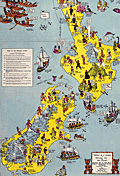| | Thumbnail | | Creator | Date | Title / Author / Date / Location | Price | | | Description |
| 7876 |  | Details | Paterson, Alan Stuart | 1940 |
| Pictorial Historical Map of New Zealand |
|
Paterson, Alan Stuart |
|
| 1940 |
| LOC:141 |
| $335.00 | Paterson--Alan-Stuart | Pictorial-Historical-Map-of-New-Zealand | Scarce cartoonish pictorial map of New Zealand ca. 1940 primarily focused on historical events related to white settlers, but with a lighthearted, comical touch. Apparently scarce; only three examples found in WorldCat, all in New Zealand institutions.
<br><br>
Drawn by Alan Stuart Patterson. Published by A.H. Reed and A.W. Reed. Dunedin, NZ. by permission of the Lands and Survey Department.
<br><br>
Paterson's clever map shows numerous historical events in New Zealand including:
<div class="indenttextblocksingle">
<ul style="list-style-type: circle;"></li>
<li>The Great Migration of the Maoris from Hawaiki to Aotearoa</li>
<li>Route of explorer Abel Tasman.</li>
<li>Treaty of Waitangi in 1840.</li>
<li>First arrival of tourists at Rotorua</li>
<li>Arrival of the 'Tory' at Port Nicholson in 1839.</li>
<li>Discovery of the succulence of Bluff Oysters</li>
</ul>
</div>
In the late 18th and early 19th centuries, European explorers, primarily from Britain, began to visit and settle in New Zealand. The first known European to sight New Zealand was Dutch navigator Abel Tasman in 1642, but it was not until the voyages of British explorer James Cook in the late 1760s and 1770s that the islands were mapped and more extensively explored. Following Cook's journeys, whalers, sealers, and traders started to visit New Zealand, establishing contact with the indigenous Māori people.
<br><br>
The early interactions between European settlers and Māori were characterized by a mix of cooperation, trade, and conflict. Many Māori initially welcomed the newcomers, as they brought new technologies, such as muskets and metal tools, which the Māori quickly adapted for their own purposes. However, the increasing European presence also led to disputes over land, resources, and cultural misunderstandings. The introduction of European diseases, to which the Māori had no immunity, also had a devastating impact on the indigenous population.
<br><br> |